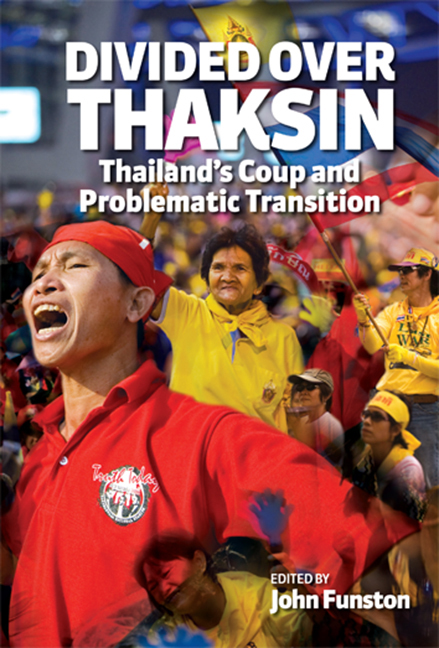Book contents
- Frontmatter
- Contents
- List of Tables and Figures
- List of Contributors
- Preface
- Introduction
- 1 Political Contests in the Advent of Bangkok's 19 September Putsch
- 2 The Tragedy of the 1997 Constitution
- 3 The NESAC, Civil Society, Good Governance and the Coup
- 4 Military Coup and Democracy in Thailand
- 5 Deconstructing the 2007 Constitution
- 6 Thailand's 2007 Constitution and Re-Emerging Democracy: Will Political Polarization Continue?
- 7 Untying the Gordian Knot: The Difficulties in Solving Southern Violence
- 8 Another Country: Reflections on the Politics of Culture and the Muslim South
- 9 Governance in the South: Is Decentralization an Option?
- 10 Tradition and Reform in Islamic Education in Southern Thailand
- 11 The Economy under the Thaksin Government: Stalled Recovery
- 12 The Thai Economy after the Coup
- 13 The Impact of Political Uncertainty on Business
- Index
11 - The Economy under the Thaksin Government: Stalled Recovery
Published online by Cambridge University Press: 21 October 2015
- Frontmatter
- Contents
- List of Tables and Figures
- List of Contributors
- Preface
- Introduction
- 1 Political Contests in the Advent of Bangkok's 19 September Putsch
- 2 The Tragedy of the 1997 Constitution
- 3 The NESAC, Civil Society, Good Governance and the Coup
- 4 Military Coup and Democracy in Thailand
- 5 Deconstructing the 2007 Constitution
- 6 Thailand's 2007 Constitution and Re-Emerging Democracy: Will Political Polarization Continue?
- 7 Untying the Gordian Knot: The Difficulties in Solving Southern Violence
- 8 Another Country: Reflections on the Politics of Culture and the Muslim South
- 9 Governance in the South: Is Decentralization an Option?
- 10 Tradition and Reform in Islamic Education in Southern Thailand
- 11 The Economy under the Thaksin Government: Stalled Recovery
- 12 The Thai Economy after the Coup
- 13 The Impact of Political Uncertainty on Business
- Index
Summary
The Thai Rak Thai government of Prime Minister Thaksin Shinawatra was elected in February 2001, promising rapid recovery from the financial crisis of 1997–98 and the speedy eradication of poverty. In September 2006 a military coup dislodged the Thai Rak Thai government, forcing Thaksin himself into exile. This chapter reviews the economic performance of the five-and-a-half years of the Thaksin government. This exercise seems especially relevant because the promises of the Thaksin government were focused on economics. On taking office, Thaksin promised a return to the double-digit growth rates of the boom decade of 1987 to 1996 and to eradicate poverty within a decade. To what extent were these promises fulfilled?
THE THAI ECONOMY IN LONG-TERM PERSPECTIVE
We begin with some long-term context. Thailand' growth performance from 1951 to 2006 is summarized in Figure 11.1, showing the level of real GDP per capita in each year (vertical bars) and its annual growth rate (solid line). The figure identifies four periods of the country' recent economic history: Pre-boom (until 1986); Boom (1987 to 1996); Crisis (1997 to 1999); and Recovery (2000 to 2006).
Table 11.1 shows that over the period 1968 to 1986, the average annual growth rate of real GNP was 6.7 per cent (almost 5 per cent per person), compared with an average of 2.4 per cent for low and middle-income countries over the same period. Then, over the decade 1987 to 1996, the Thai economy boomed and it was the fastest growing in the world. The twin currency and banking crises of 1997–99 ended this boom, eroding some, but definitely not all, of the gains that had been made over the preceding decades.
As we shall see below, Thailand' boom was driven by very high levels of investment, both domestic and foreign, in physical capital. Even more remarkable than the rate of growth over this long period was the stability of the growth. Not a single year of negative growth of real output per head of population was experienced over the four decades from 1958 to 1996, a unique achievement among oil importing developing countries.
Thailand' performance was often described as an example others might emulate. Its principal economic institutions, including its central bank, the Bank of Thailand, were often cited as examples of competent and stable management.
- Type
- Chapter
- Information
- Divided Over ThaksinThailand's Coup and Problematic Transition, pp. 150 - 171Publisher: ISEAS–Yusof Ishak InstitutePrint publication year: 2009

